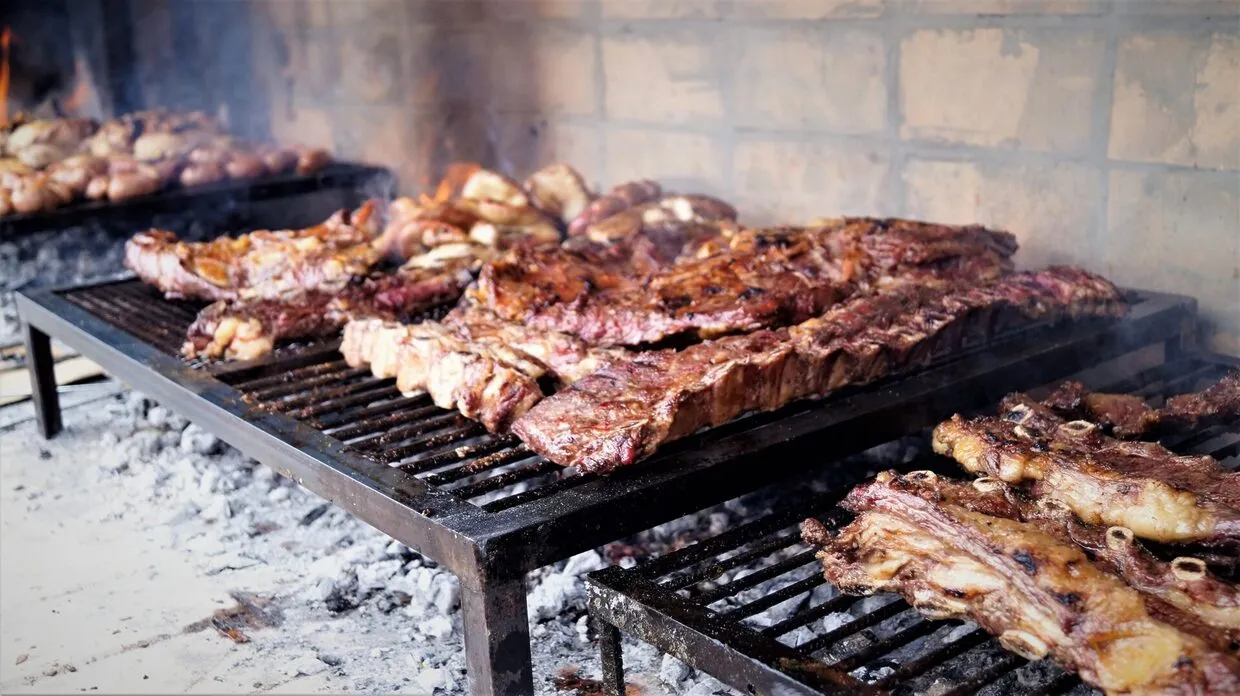Everything you need to know about Argentina’s most iconic tradition and national dish. Social gathering, assorted grilled meats, and an all-day affair: asado is all that and more, as we will explain in this article.
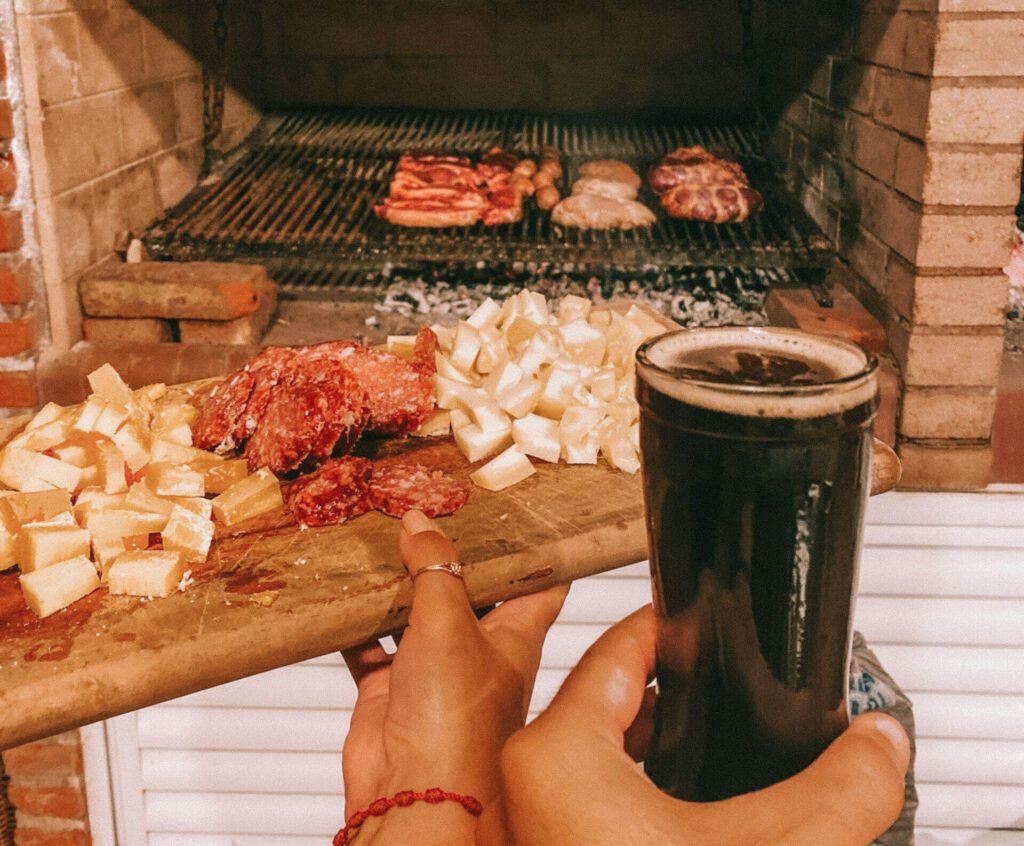
What is asado?
Asado is both a cooking technique and a social event akin to a barbecue. In Argentina, asado is one of the most important national traditions.
Asado as a barbecue
As a barbecue, asado consists of a variety of grilled meats, primarily beef, although pork and chicken are also used. In addition to the meats, several “embutidos” (sausages) and “achuras” (offal) are served, as well as side dishes, grilled vegetables, and sometimes grilled provoleta cheese.
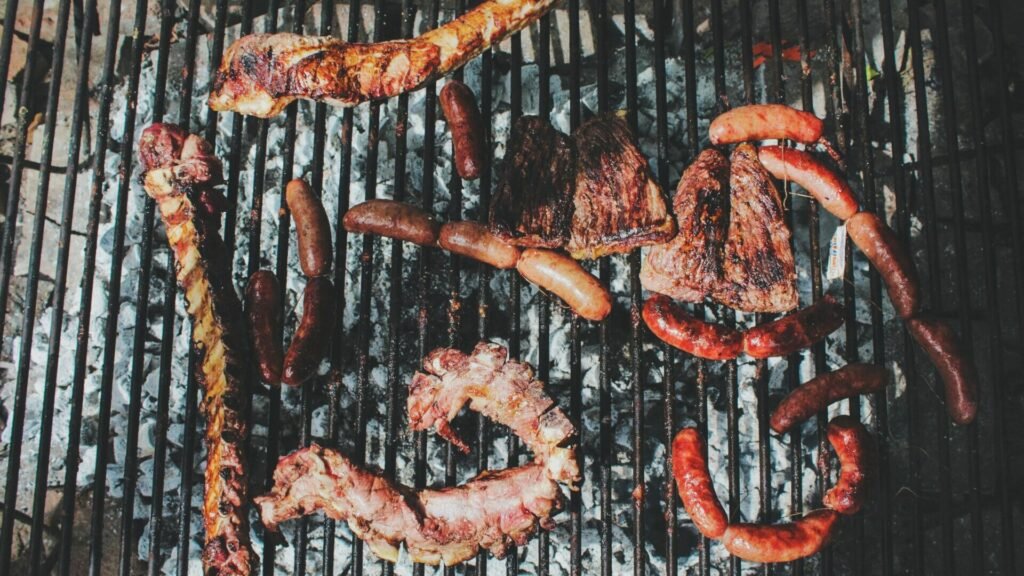
Asado beef cuts
Let’s go over some of the most popular asado meats. There are a lot of options and regional variety. In the city of Buenos Aires and its parrillas, the typical cuts are:
- Tira de asado (Argentine short rib): the go-to asado meat cut. It has more bone and fat than other cuts but is very flavourful.
- Vacío (flank steak): an affordable and juicy cut with a thin layer of fat on the sides. It’s quite thin.
- Entraña (skirt steak): thinner than vacío, with a white layer of fat that gets very crispy once cooked.
- Lomo (tenderloin): a lean cut with a hefty price tag, usually reserved for fine dining (like high-end parrillas) but seen at asados on special occasions.
Other popular cuts are tapa de asado (rib cap) and bife de chorizo (sirloin).
Matambre de cerdo (pork rose meat) and bondiola (pork tenderloin), when used, are prepared with lemon juice and then cooked on the grill as well.
Asado sausages
- Chorizo (sausage): everyone’s favorite sausage, chorizo is a traditional pork sausage typically eaten as is or in a “choripán”, that is, a chorizo sandwich. You may add chimichurri for an extra something.
- Morcilla (blood sausage): not as vital as chorizo, but an asado staple nonetheless. It tastes better served hot, but leftover cold morcilla can be served as picada (we'll explain the picada later).
- Salchicha parrillera (thin sausage): If you are not up for a chorizo but still want a sausage, this is the one for you.
Asado offal (achuras)
The achuras are always a gamble. When properly prepared, they can be fantastic. If not, well, you can always put them aside.
- Chinchulines: chitterlings.
- Mollejas: sweetbreads.
- Lengua: tongue.
Asado side dishes
An asado is all about the meats, so the side dishes are usually there to “enhance” the experience.
- Green salad: simple, easy to whip up, no-nonsense salad featuring tomatoes and lettuce. You can also add carrots and onions.
- Potato salad: boiled potatoes, boiled eggs, a whole lotta mayonnaise.
- Vegetales a las brasas (grilled veggies): bell peppers, potatoes, onions, and corn. Wrap these bad boys on foil paper and put them on the grill.
- Provoleta cheese: a local variation of Provolone cheese, ideal for grilling. Season it with chimichurri or spices and olive oil before cooking.
Asado sauces
Argentines don’t season their cuts besides adding salt, but they enjoy adding sauces once the cut has been served. Popular options are chimichurri and salsa criolla, both Argentine in origin.
What is chimichurri?
Chimichurri is a sauce made with finely chopped parsley, oregano, garlic, oil, and some vinegar or lemon juice. Chimichurri tastes better when fresh herbs are used. You can spice the sauce up by adding red pepper flakes (ají molido).
What is salsa criolla?
Salsa criolla is another uncooked sauce made with thinly sliced onions, bell peppers (red or green), and tomatoes. Olive oil, vinegar, and salt and pepper are also used to add flavor.

Asado as a social gathering
An asado is an all-day affair; the designated asador (the person in charge of the grill) starts the fire very early on, just as guests are arriving. While the asador is at work, the others help set the table and prepare the side dishes. When everything is in place, the picada is served.
What is a picada?
A picada is an appetizer, usually served on a tray and consisting of a variety of cheeses, cold cuts, bread slices, olives, and other snacks. The verb “picar” means to snack.
Many ingredients can go into a picada, but salamín (salami), pategrás cheese, and olives are common picada choices, typically served with slices of bread.
Once people start eating, they also start drinking: expect the first of many Malbec bottles to be opened at this point. Alternatively, people may go for a cocktail, such as Argentina’s infamous fernet con coca, one of our most traditional drinks.
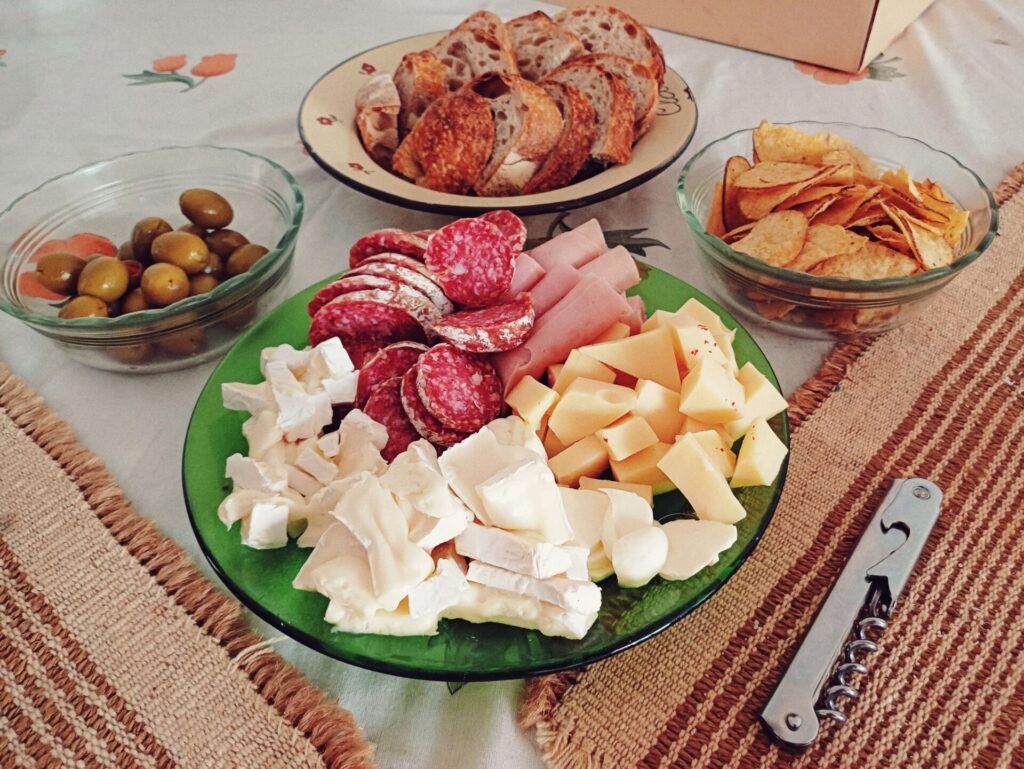
Asado Entrées
The parrilla (grill) should be up and running by now, with the first cuts laid out on the grill. Argentines don’t season their meats besides adding salt; pork cuts may be prepared with some lemon juice, and that’s it.
The first thing out of the grill will be the chorizos (sausages), which are always a huge crowd-pleaser. There’s bound to be bread at the table, so guests can prepare their very own choripán (chorizo sandwich), or “chori” for short. Morcilla (blood sausage) and salchicha parrillera (thin sausage) will also be served at this point.
Sauces such as chimichurri and salsa criolla can be added to your chori for extra flavor. Neither is spicy, as Argentines aren’t particularly fond of the heat.
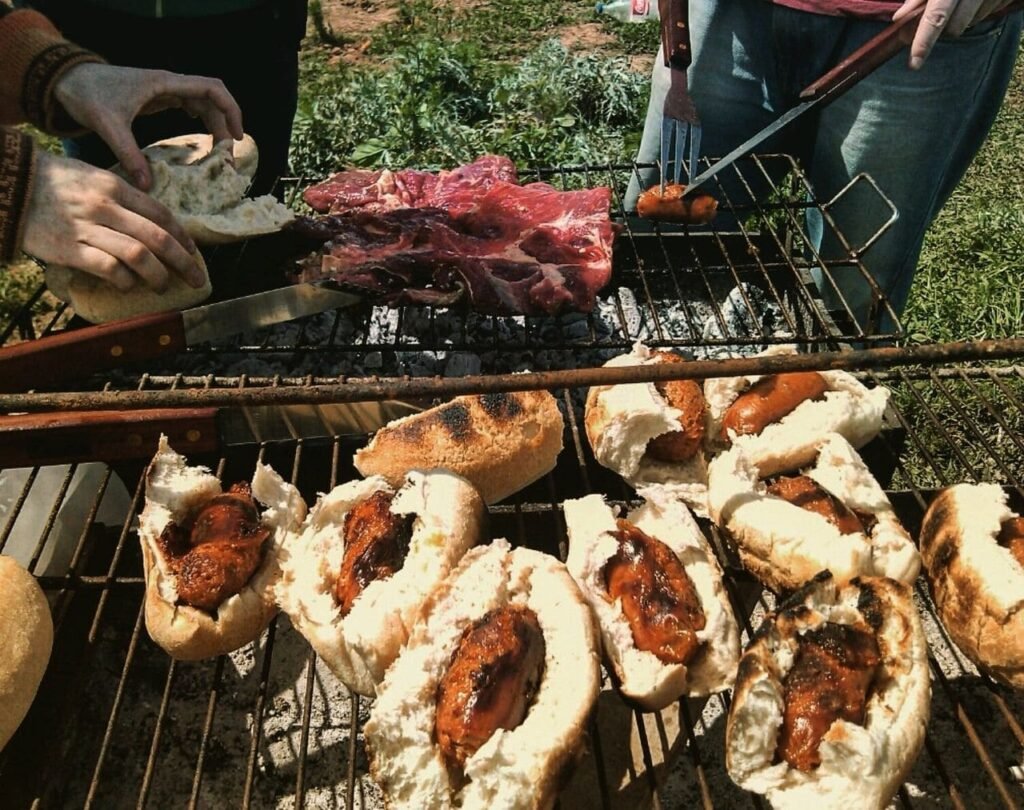
Asado cuts are served
Next comes the offal and the main asado cuts (although the offal is sometimes served first). By this point, everybody should take their seat. The asador will take the biggest cut out of the grill, serve it on the table, and then cut it. A round of applause for the asador is customary, to congratulate them on an asado well done.
What’s left is to eat, chat, drink, and eat some more while the rest of the cuts are served. The asador will sit down once everything is out of the grill, but they usually eat a little bit of each cut as they serve them.
Time for Dessert
The main event is over, but the feast continues. Coffee and dessert will be served next. Some people serve ice cream (in Argentina, you can buy artisanal ice cream in bulk at any ice cream shop). Others serve tiramisú or maybe a cake such as chocotorta. A mate will probably be passed around.
At the end of an asado, you should feel full, happy, and ready for a long nap.
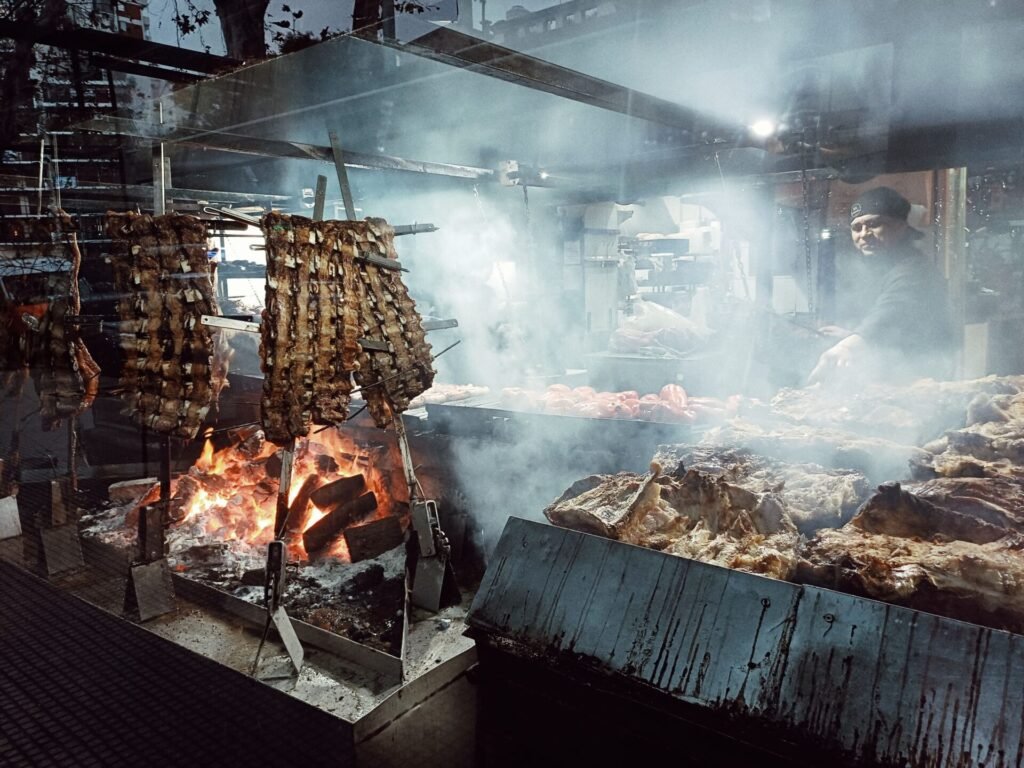
Where can I eat asado in Buenos Aires?
On to the hard part: the best way to eat asado is to be invited to one. Befriending an Argentine is easy, but if you are in town for just a couple of days, chances are you won’t get your invitation in time.
However, you can always head to a local parrilla (steakhouse) to enjoy some perfectly cooked asado meats and side dishes. It’s not the same as an asado, but it’s the closest thing to it.
We put together a list of the best steakhouses in Buenos Aires for those of you looking for a nice Argentine steak. There’s also the Fogón Asado Experience, which is a bit more like a real asado than a regular parrilla.
Asado questions and trivia
How do you start a fire for an asado in Argentina?
Argentines typically use dry wood or charcoal. You assemble a small pile of paper, small branches, and/or straw first, and then light the wood or charcoal on top. Then gradually add more wood or charcoal until there’s enough lit up to use the grill. Charcoal works faster and is more efficient, while wood takes longer but makes for a better aftertaste.
What is asado a la cruz?
In the countryside, another way of preparing an asado is by lighting a fire and then “staking” the cut - usually a costillar (rib rack) or another big cut - on a cross-like steel contraption.
What are the asado cooking points?
Jugoso: medium-rare, not to be confused with “blue”.
A punto: true medium, with some pink in the middle.
Pasado de punto: between medium and well done.
Cocido: well done.
Suela: thoroughly cooked. Suela means “shoe sole”.
What to eat at an asado if I'm vegetarian
Vegetarians can enjoy provoleta (grilled provolone-type cheese) and roasted vegetables such as red pepper, potatoes, onions and corn. Filled vegetables are also an option, such as red peppers with mozzarella or fried egg on top.
Vegans can enjoy a variety of grilled veggies with chimichurri or salsa criolla. Green salads are usually safe for vegans to eat too. Be sure to ask the host to wrap your veggies in tin foil so they aren't touching any of the meat cuts or non-vegan ingredients. In Buenos Aires, some specialty shops and dietéticas (health food shops) sell plant-based vegan meats for the grill. If you are in a pinch, you can buy vegan burgers at big supermarkets from brands such as NotCo and bring them to your asado.
What to bring to an asado
If you are invited to an asado, it's polite to ask the host if there's anything you can bring. They may ask you to bring a salad, dessert, bread, ice or something to drink. If they say they don't need anything, bringing a bottle of Malbec is a classy move.
